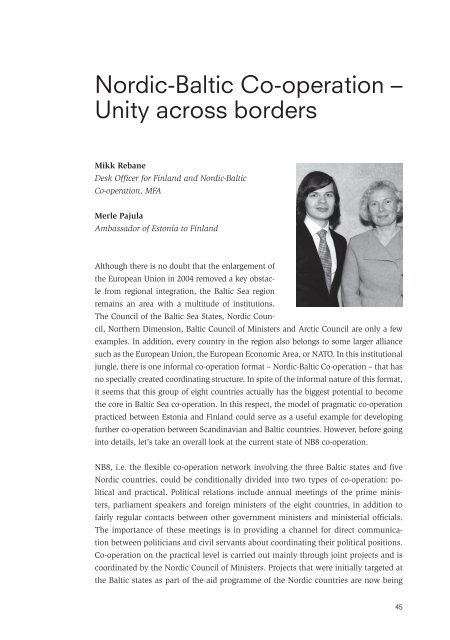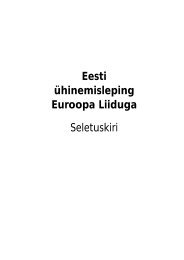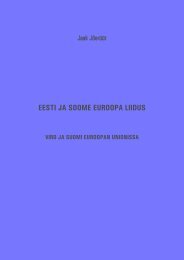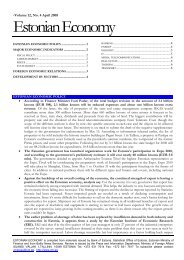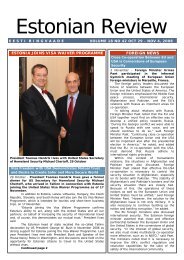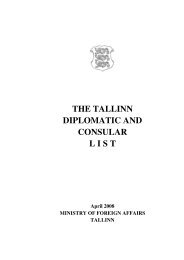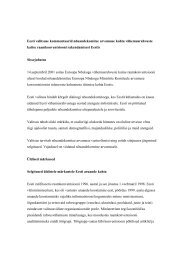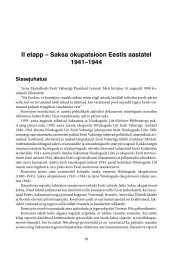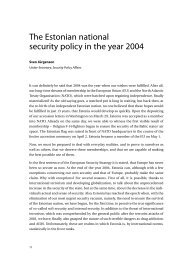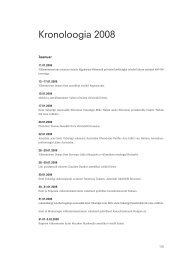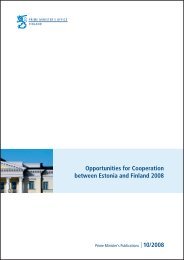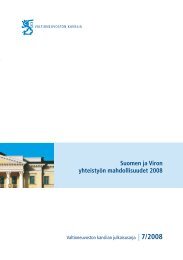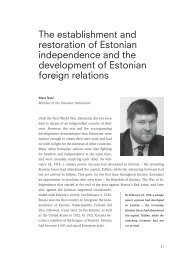Nordic-Baltic Co-operation – Unity across borders
Nordic-Baltic Co-operation – Unity across borders
Nordic-Baltic Co-operation – Unity across borders
Create successful ePaper yourself
Turn your PDF publications into a flip-book with our unique Google optimized e-Paper software.
<strong>Nordic</strong>-<strong>Baltic</strong> <strong>Co</strong>-<strong>operation</strong> <strong>–</strong><br />
<strong>Unity</strong> <strong>across</strong> <strong>borders</strong><br />
Mikk Rebane<br />
Desk Officer for Finland and <strong>Nordic</strong>-<strong>Baltic</strong><br />
<strong>Co</strong>-<strong>operation</strong>, MFA<br />
Merle Pajula<br />
Ambassador of Estonia to Finland<br />
Although there is no doubt that the enlargement of<br />
the European Union in 2004 removed a key obstacle<br />
from regional integration, the <strong>Baltic</strong> Sea region<br />
remains an area with a multitude of institutions.<br />
The <strong>Co</strong>uncil of the <strong>Baltic</strong> Sea States, <strong>Nordic</strong> <strong>Co</strong>uncil,<br />
Northern Dimension, <strong>Baltic</strong> <strong>Co</strong>uncil of Ministers and Arctic <strong>Co</strong>uncil are only a few<br />
examples. In addition, every country in the region also belongs to some larger alliance<br />
such as the European Union, the European Economic Area, or NATO. In this institutional<br />
jungle, there is one informal co-<strong>operation</strong> format <strong>–</strong> <strong>Nordic</strong>-<strong>Baltic</strong> <strong>Co</strong>-<strong>operation</strong> <strong>–</strong> that has<br />
no specially created coordinating structure. In spite of the informal nature of this format,<br />
it seems that this group of eight countries actually has the biggest potential to become<br />
the core in <strong>Baltic</strong> Sea co-<strong>operation</strong>. In this respect, the model of pragmatic co-<strong>operation</strong><br />
practiced between Estonia and Finland could serve as a useful example for developing<br />
further co-<strong>operation</strong> between Scandinavian and <strong>Baltic</strong> countries. However, before going<br />
into details, let’s take an overall look at the current state of NB8 co-<strong>operation</strong>.<br />
NB8, i.e. the flexible co-<strong>operation</strong> network involving the three <strong>Baltic</strong> states and five<br />
<strong>Nordic</strong> countries, could be conditionally divided into two types of co-<strong>operation</strong>: political<br />
and practical. Political relations include annual meetings of the prime ministers,<br />
parliament speakers and foreign ministers of the eight countries, in addition to<br />
fairly regular contacts between other government ministers and ministerial officials.<br />
The importance of these meetings is in providing a channel for direct communication<br />
between politicians and civil servants about coordinating their political positions.<br />
<strong>Co</strong>-<strong>operation</strong> on the practical level is carried out mainly through joint projects and is<br />
coordinated by the <strong>Nordic</strong> <strong>Co</strong>uncil of Ministers. Projects that were initially targeted at<br />
the <strong>Baltic</strong> states as part of the aid programme of the <strong>Nordic</strong> countries are now being<br />
45
2008 / 2009<br />
ESTONIAN MINISTRY OF FOREIGN AFFAIRS YEARBOOK<br />
substituted with co-<strong>operation</strong> programs between equal partners. The first to be implemented<br />
was the grant program NORDPLUS 2008<strong>–</strong>2011 in the field of education; in<br />
2009 three other programmes will be launched in the sphere of business and industry,<br />
public administration, and culture. A good example of practical co-<strong>operation</strong> is the<br />
fact that Estonia, Latvia and Lithuania became shareholders of the <strong>Nordic</strong> Investment<br />
Bank in 2005. Political and practical co-<strong>operation</strong> is kept as flexible as possible since<br />
all eight countries must have a common interest in specific projects.<br />
What are the benefits of the unity of the NB8 countries? First of all, speaking globally<br />
with a louder voice and stimulating prosperity in the region. In a situation where the<br />
interests of large states still play an important role in the developments that are taking<br />
place in Europe and the rest of the world, the coordinated activities of small countries<br />
that are similar both geographically and in core values provides an opportunity to act<br />
as an equal partner. This does not require central institutions or common symbols,<br />
but simply joint values, shared concerns and interests. Instead of creating new institutions,<br />
there are existing structures that can be put to excellent use. During the next<br />
decade, the presidency of the European Union will be held by one of the NB8 member<br />
states on average once every two years (in the second half of 2009 it will be Sweden).<br />
Last year the president of the OSCE was Finland and in 2011 it will be Lithuania.<br />
There are also other outlets for global protection of common values: for instance, it<br />
is probably in the interest of all NB8 countries to involve the <strong>Baltic</strong> countries in the<br />
already well-functioning <strong>Nordic</strong> co-<strong>operation</strong> that is implemented when the countries<br />
apply for positions in UN bodies.<br />
An excellent opportunity for increasing the global<br />
influence of NB8 countries is to share experiences An excellent opportunity for increasing<br />
the global influence<br />
and join resources in supporting the security and<br />
development of distant regions. A report prepared of NB8 countries is to share experiences<br />
and join resources in<br />
in co-<strong>operation</strong> with the Estonian International<br />
Centre for Defence Studies and the Swedish Defence<br />
Research Agency 1 recommends that one velopment of distant regions.<br />
supporting the security and de-<br />
flagship issue of the <strong>Nordic</strong>-<strong>Baltic</strong> co-<strong>operation</strong><br />
should be to share experiences in security sector<br />
reform with third countries. The first steps in this direction were taken in 2006, when<br />
the <strong>Nordic</strong>-<strong>Baltic</strong> Initiative started to assist Ukraine in reforming its defence sector. The<br />
second important example of co-<strong>operation</strong> is the EU’s <strong>Nordic</strong> Battle Group (NBG), to<br />
which manpower was contributed by Estonia, Norway, Sweden, Finland and Ireland.<br />
The NBG was on standby in the first half of 2008 and will be ready for deployment<br />
again in 2011. In the area of security co-<strong>operation</strong>, the different security policy choices<br />
1<br />
http://www2.foi.se/rapp/foir2346.pdf<br />
46
NORDIC-BALTIC CO-OPERATION <strong>–</strong> UNITY ACROSS BORDERS<br />
2008 / 2009<br />
A meeting of the <strong>Nordic</strong> and <strong>Baltic</strong> foreign ministers in Pärnu 09. <strong>–</strong> 10.09.2008. Taking a nature walk through a bog.<br />
of the NB8 countries are not regarded as a problem. It is rather an example of successful<br />
co-<strong>operation</strong> over institutional boundaries based on common interests.<br />
The co-<strong>operation</strong> of NB8 countries could also create added value in other areas.<br />
For instance, in March 2008 Estonia hosted a workshop in Tallinn for NB8 foreign<br />
ministries’ experts on African matters that gave representatives of the <strong>Baltic</strong> states<br />
valuable information on the long-term co-<strong>operation</strong> experience of <strong>Nordic</strong> countries in<br />
Africa. The workshop concluded that there were opportunities for joint activities in<br />
Africa, and that similar meetings should be arranged again in the future. In May, the<br />
Foreign Ministry and the Estonian Chamber of <strong>Co</strong>mmerce and Industry organised the<br />
<strong>Baltic</strong>-<strong>Nordic</strong>-Western Balkans Business Forum, the objective of which was to present<br />
the business climate of the Western Balkans and find ways to develop a co-<strong>operation</strong><br />
network between the businessmen and enterprise organisations of the regions.<br />
<strong>Nordic</strong>-<strong>Baltic</strong> co-<strong>operation</strong> also plays an important role within the framework of the European<br />
Union. The <strong>Nordic</strong> and <strong>Baltic</strong> EU member states’ foreign ministers (NB6) have<br />
monthly meetings in Brussels and the heads of government also meet frequently. The<br />
common part of the values promoted by <strong>Nordic</strong> and <strong>Baltic</strong> countries clearly complies with<br />
the co-<strong>operation</strong> directions agreed upon in the European Union. In spite of some national<br />
differences, all NB6 countries generally support abolishing protectionism and removing<br />
existing barriers from the four freedoms of the EU. Moreover, all six countries have been<br />
consistently supporting the EU enlargement process. Therefore, one of the guiding principles<br />
of <strong>Nordic</strong>-<strong>Baltic</strong> co-<strong>operation</strong> could well be to promote these EU co-<strong>operation</strong> spheres<br />
that have not yet been universally implemented by all 27 Member States, in particular, the<br />
47
2008 / 2009<br />
ESTONIAN MINISTRY OF FOREIGN AFFAIRS YEARBOOK<br />
meeting of the targets of the Lisbon Strategy and safeguarding the functioning of the four<br />
freedoms in reality. There are also no obstacles to involving Norway and Iceland in this<br />
co-<strong>operation</strong>, since all four EU freedoms and a significant share of acquis communautaire<br />
already apply to them through the European Economic Area.<br />
In their joint actions aimed at improving the competitiveness<br />
of the <strong>Baltic</strong> Sea Region, the NB8 group NB8 states can jointly contribute<br />
to the securing of the re-<br />
could learn a lesson or two from the mutually beneficial<br />
Estonian-Finnish bilateral co-<strong>operation</strong> that gion’s wellbeing and security<br />
is focusing on the grass-roots level. Further possibilities<br />
for Estonian-Finnish co-<strong>operation</strong> were and co-<strong>operation</strong> in the field of<br />
by converging energy markets<br />
mapped in the report “Opportunities for <strong>Co</strong>-<strong>operation</strong><br />
between Estonia and Finland, 2008” 2 , which and internal security.<br />
marine environment, transport<br />
was commissioned by the prime ministers of Estonia<br />
and Finland. The report, which was unveiled<br />
in June 2008, was modelled on the objectives of the Lisbon Strategy and on the need<br />
to better stimulate the competitive ability of the <strong>Baltic</strong> Sea Region. <strong>Nordic</strong>-<strong>Baltic</strong> co<strong>operation</strong><br />
could also be employed to develop the <strong>Baltic</strong> Sea Region into an innovative<br />
and competitive area in the true spirit of the Lisbon Strategy by focusing on the free<br />
movement of people and knowledge, and the development of a harmonised, attractive<br />
and innovative business environment. <strong>Nordic</strong> countries that today top the world rankings<br />
in competitiveness risk to lose this position without innovation in productivity<br />
and integration of national markets. In addition, NB8 states can jointly contribute to<br />
the securing of the region’s wellbeing and security by converging energy markets and<br />
co-<strong>operation</strong> in the field of marine environment, transport and internal security.<br />
A key issue in the development of the competitiveness of the <strong>Baltic</strong> Sea Region is the contribution<br />
of Germany and Poland and, indirectly, other EU Member States by implementing<br />
the EU’s <strong>Baltic</strong> Sea Strategy. It is equally important to engage Russia in regional co-<strong>operation</strong><br />
efforts, an objective that is being specifically addressed by the <strong>Nordic</strong> Dimension. But<br />
it seems that only the <strong>Nordic</strong> and <strong>Baltic</strong> countries that are already closely co-operating in<br />
various spheres have the preconditions and interest to belong to the joint “core” of the<br />
region. They are working together on new channels to promote their values in the world<br />
and to combine their resources for safeguarding security and stability outside the region<br />
as well. Still, their key objective is to develop the <strong>Baltic</strong> Sea Region into an area that could<br />
serve as a model for the whole European Union. In doing so, the idea is not to turn NB8<br />
into an organisation (like the <strong>Nordic</strong> <strong>Co</strong>uncil of Ministers) nor the cultural or social harmonisation<br />
of the <strong>Nordic</strong> and <strong>Baltic</strong> countries, but rather a close supra-structural co-<strong>operation</strong><br />
format based on joint values and interests both on the political and practical level.<br />
2<br />
http://web-static.vm.ee/static/failid/131/Opportunities_for_<strong>Co</strong><strong>operation</strong>_between_Estonia-Finland2008.pdf<br />
48


